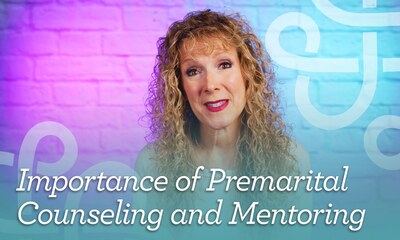Finally, Some Good News About Divorce

After a number of decades of mostly grim news about increasing divorce rates and the growing threats to the institution of marriage, some encouraging signs are appearing on the horizon.
According to experts who track trends and dive deep into the various data sets, one consensus is emerging:
The divorce rate in the U.S. is not 50%, and probably has never been that high.
In a 2014 N.Y. Times article “The Divorce Surge Is Over, but the Myth Lives On” Claire Cain Miller notes:
“But here is the thing: It is no longer true that the divorce rate is rising, or that half of all marriages end in divorce. It has not been for some time. Even though social scientists have tried to debunk those myths, somehow the conventional wisdom has held.”
In the early 2000’s author Shaunti Feldhahn began examining the data and statistics behind the divorce rate. After an investigative study that stretched into years (yes, it took that long) her findings debunked the myth. She found that in the U.S. the divorce rate has only approached the 50% mark one time (in the late 1970s and early 1980s), and has never since reached that level. According to her research, the current, overall divorce rate is probably closer to 33%.
Not only is this number more hopeful than what is commonly believed, it gets even better for those in first marriages. She writes:
“No one knows what the average first-marriage divorce rate actually is, but based on the rate of widowhood and other factors, we can estimate it is probably closer to 20-25%.”
A divorce rate in the 20-25% range! This will come as a pleasant surprise to many, especially given how entrenched the 50% myth is in our culture. Such hopeful and encouraging news ought to be shared as frequently as the myth was— extensively posted, broadly tweeted and widely shared—and the focus of as many Sunday sermons as possible.
And the news gets even better for those in some key subcategories. For example, couples that received premarital education had a 31% lower chance of divorce, according to marriage expert Scott Stanley. He found that premarital counseling "is associated with higher levels of marital satisfaction, lower levels of destructive conflicts and higher levels of interpersonal commitment to spouses." The number of hours spent in premarital programs ranged from as little as a few hours to 20 hours, with an average of eight hours. (Also, having a college education drops the rate by almost 30%.)
There is also more encouraging news for couples considering marriage, for we now know of some easy-to-spot signs that actually predict divorce before you get married. Marriage experts have found the destructive patterns that show up in a relationship that can foretell future problems. Thus, with early identification, it gives couples a fighting chance to work on them early in the relationship, before they become problems.
What are the signs that can actually predict divorce?
-
Mismanaged conflict and a deterioration of intimacy. All couples argue, but experts point out that it is not about how much you argue, rather it is about how you argue. Learn to do it well, and conflict can actually increase feelings of intimacy. Couples should get help if their arguments rapidly become negative, never get resolved, and leave one or the other feeling unheard, attacked or misunderstood.
-
Believing “myths” about marriage. Along with misplaced concerns about the likelihood of failure (“The odds are against us if 50% of marriages end in divorce”), myths like “Marriage will complete me,” or, “I married my soul-mate and will now be happy,” or, “Marriage is easy and should not take a lot of work,” lead couples to become too easily discouraged, and too likely to bail when problems arise.
-
Unhealthy ways of interacting and communicating. Destructive patterns often build upon each other, sabotaging a couple's attempts to communicate with each other. Marriage expert John Gottman calls some of these the “Four Horsemen of the Apocalypse.” His list includes blaming and attacking a spouse's personality and character (criticism), intentionally insulting the other with name-calling, hostile humor, sneering and eye-rolling (contempt), denying responsibility, making excuses, with neither person taking responsibility for setting things right (defensiveness), or simply refusing to communicate or removing oneself from the conversation (stonewalling).
The above signs are encouraging for this reason: If we can help couples become aware the issues before they marry, and provide them the antidotes to the destructive patterns, it is possible to further slow down the rate of divorce for those in a first marriage.
That is in fact what Justin Wolfers, economist at the University of Michigan, found in his study of the recently married: Couples who married in the 2000’s are divorcing at even lower rates, and as such, if the trend continues, only one-third of marriages (if not fewer) will involve a divorce.
So here is the hopeful bottom-line: If you are currently married, or planning or wanting to get married in the next few years, your chances of experiencing a divorce are actually far below 50%. This good news is something that social scientist in the field of marriage and relationships know, and that can hopefully begin to change our culture’s stubborn misperceptions about divorce.
Excellent Sources:
https://shaunti.com/2014/05/busting-cultural-myths-marriage-divorce/
Feldhahn, Shaunti; with Whitehead, Tally. (2014) The Good News About Marriage: Debunking Discouraging Myths about Marriage and Divorce
National Marriage Project and Institute for American Values
http://nationalmarriageproject...
Gottman, John. (1994). Why Marriages Succeed or Fail. Simon & Schuster.
Gottman, John. (1999). The Seven Principles for Making Marriage Work. Crown Books.
Markman, H.J., Stanley, S. and Blumberg. (1994). Fighting for Your Marriage. San Francisco, Jossey-Bass, Inc.
Stanley, Scott M.; Amato, Paul R.; Johnson, Christine A.; Markman, Howard J. Premarital education, marital quality, and marital stability: Findings from a large, random household survey. Journal of Family Psychology, Vol 20(1), Mar 2006, 117-126.
Miller, Claire C. (2014). The Divorce Surge Is Over, but the Myth Lives On




